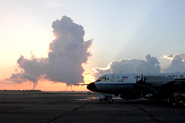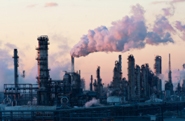11 August 2010
WASHINGTON—A thick blanket of yellow haze hovering over Houston as a result of chemical pollution from petroleum products may be getting a little bit thinner, according to a new study. But the new findings — which have implications for petrochemical-producing cities around the world — come with a catch, says a team of scientists who participated in the research.
The problem is that industry still significantly underestimates the amounts of reactive chemicals being released into the air, according to airplane measurements made by the research team as part of the study. “Emissions may have decreased some, but there’s still a long way to go,” said study author and atmospheric scientist Joost de Gouw. “And the emission inventories by industry were not any better in 2006 than they were in 2000.”
De Gouw is with the Cooperative Institute for Research in Environmental Sciences (CIRES), a joint institute of the University of Colorado at Boulder and the National Oceanic and Atmospheric Administration. The findings by him and his colleagues at CIRES and other institutions have been accepted for publication in the Journal of Geophysical Research – Atmospheres, a publication of the American Geophysical Union.
Inaccuracies in the reporting of emissions pose big challenges for the reduction and regulation of emissions coming from petrochemical plants. The emissions are important to monitor, because some chemicals released from the plants react to form ground-level ozone that can be harmful to human health and agricultural crops.
States that regularly suffer from ozone problems (Texas is one of them) are required by the federal government to scientifically model what happens during air pollution episodes and develop plans for mitigation. For that to happen effectively, modelers need accurate inventories, says the research team.
“Initial inventories are not based on measurements. They’re based on estimates,” said de Gouw. “When we go back to verify those estimates, we find they’re not very accurate.”
To check on those estimates, lead study author Rebecca Washenfelder of NOAA’s Earth System Research Laboratory and CIRES, along with de Gouw, flew into the plumes in an aircraft, the NOAA WP-3D, outfitted with an array of air quality measuring instruments. The plane sampled emissions over Houston as part of the second Texas Air Quality Study in 2006, analyzing air for signs of ingredients of the chemical reaction that makes ozone, including nitrogen oxides and reactive hydrocarbons.
Washenfelder, de Gouw, and their study colleagues compared these measurements with data taken during similar flyovers from the first Texas Air Quality Study in 2000 and another flight in 2002. They then compared those measurements against industry-reported emissions inventories for each year. In all cases, the inventories sent to the U.S. Environmental Protection Agency didn’t agree with measured amounts of pollutants.
The conflicting data is likely a problem of estimation and general industry practice. “There are tens of thousands of valves and fittings installed throughout the plants in most cases with an assumed, not measured, leak rate for each,” Washenfelder said.
But industry is taking steps to lessen ozone-causing emissions, and repairs to petrochemical plants may have contributed to recent emission declines. Washenfelder and de Gouw found that the concentrations of ethene and propene — which both contribute to ozone formation — dropped by 52 percent and 48 percent respectively between 2000 and 2006.

NOAA’s WD-P3 sits on the tarmac in Houston. This plane flew through emissions plumes to sample the air coming out of petrochemical plants in Houston and the surrounding region. Photo credit: Bill Dube, NOAA
The two scientists see this study as a wake-up call for emissions monitoring. “There are a lot of discussions with the petrochemical industry on how to measure these things instead of relying on estimates,” said de Gouw. “I think the number one issue here is awareness. As soon as industry is aware that there could be emissions problems down the road, they can figure out how to fix them at lower cost.”
Funding for the project came from NOAA Air Quality, NOAA Climate Research and Modeling Program, the Texas Commission on Environmental Quality, and a National Research Council Postdoctoral fellowship.
Joint Release
American Geophysical Union Cooperative Institute for Research in Environmental Sciences
AGU Contact:
Kathleen O’Neil, +1 (202) 777-7524, [email protected]
CIRES Contact:
Morgan Heim, +1 (303) 492-6289, [email protected]
As of the date of this press release, the paper by Washenfelder et al. is still “in press” (i.e. not yet published). Journalists and public information officers (PIOs) of educational and scientific institutions who have registered with AGU can download a PDF copy of this paper in press.
Or, you may order a copy of the paper by emailing your request to Kathleen O’Neil at [email protected]. Please provide your name, the name of your publication, and your phone number.
Neither the paper nor this press release are under embargo.
“Characterization of NOx, SO2, ethene, and propene from industrial emission sources in Houston, Texas”
R. A. Washenfelder, G. J. Frost, J.A. De Gouw, J Peischl: Cooperative Institute for Research in Environmental Sciences, University of Colorado, Boulder, Colorado, USA, and Chemical Sciences Division, Earth System Research Laboratory, National Oceanic and Atmospheric Administration, Boulder, Colorado, USA;
M. Trainer, T.B. Ryerson, D.D. Parrish: Chemical Sciences Division, Earth System Research Laboratory, National Oceanic and Atmospheric Administration, Boulder, Colorado, USA;
E.L. Atlas: Division of Marine and Atmospheric Chemistry, University of Miami, Miami, Florida, USA;
F.M. Flocke, A. Fried, D. Richter, S.M. Schauffler, J.G. Walega, P. Weibring, W. Zheng: Earth Observing Laboratory, National Center for Atmospheric Research, Boulder, Colorado, USA.
Rebecca Washenfelder, CIRES: 303-492-3810, [email protected]
Joost de Gouw, CIRES: 303-497-3878, [email protected]
